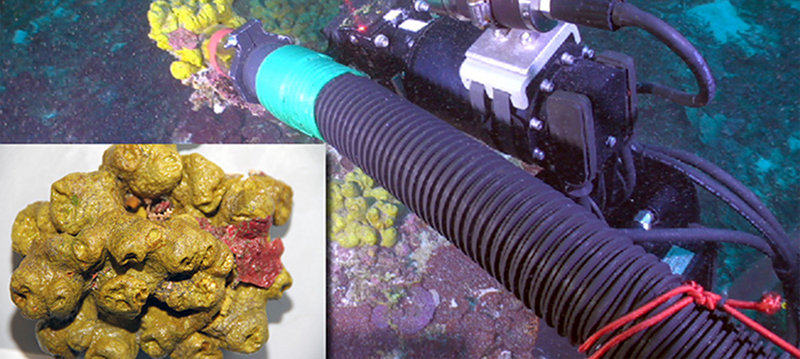
By Brian Cousin - Florida Atlantic University — Harbor Branch
August 31, 2015

The remotely operated vehicle collected a sample of Spongosorites. The inset photo shows the same sponge in the R/V F.G. Walton Smith wet lab. This sponge is known to contain a compound with powerful anti-inflammatory properties. Image courtesy of Brian Cousin, FAU-Harbor Branch. Download larger version (jpg, 483 KB).
We dove at three separate sites on Pulley Ridge to document the benthic habitat and collect samples for taxonomic identification. Pulley Ridge has a diversity of bottom characteristics and we were treated to two dramatically different types.
During the morning remotely operated vehicle (ROV) dive (covering two sites), we discovered the bottom was rich in sponge species. On our afternoon ROV dive (covering one site), the ROV camera returned images of a more sparsely populated sandy bottom.

The remotely operated vehicle lab during a dive. Jason White of the University of North Carolina at Wilmington’s Undersea Vehicles Program is at the pilot’s controls. Image courtesy of Brian Cousin, FAU Harbor Branch.. Download larger version (jpg, 486 KB).
During the afternoon ROV dive, winds unexpectedly whipped up to 29 knots, blowing five-foot waves across the surface of the Gulf of Mexico and forcing an early termination of our dive. Was this a reforming of Tropical Storm Erika? Possibly.

Where’s the pipefish? A pipefish encountered by the remotely operated vehicle has a relatively long body to hide from predators. Image courtesy of Brian Cousin, FAU Harbor Branch. Download larger version (jpg, 739 KB).
Recovery of the ROV required well-coordinated efforts between the ROV team on the deck, pilot Jason White in the ROV lab, and the ship’s crew. The most critical part of the recovery comes when the ROV is close to the ship. An impact between the ROV and the ship's aluminum hull would be most unfavorable to the ROV and its suite of electronic equipment. When seas are rough, the team needs to time this stage precisely, minimizing the amount of time the ROV can swing in the air on the steel cable hoisting it from the water. Fortunately, the team prevailed and recovered the ROV onto the deck without incident.
The early end to today’s operations gave the team a chance to rest and prepare for the next days’ ambitious schedule of ROV dives covering an unprecedented five sites.